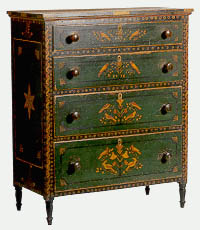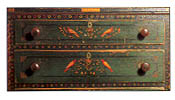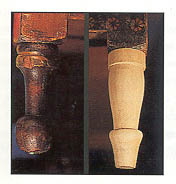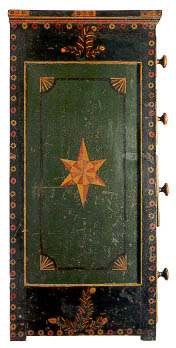
This section of the web site features projects conducted by members of the society. Topics could include synopses of current projects, short articles, or position pieces on particular topics or events of interest to the membership. Please contact Lisa Lock if you would like to contribute to this section.

50th
Anniversary Abstracts available! |
Relive the memories Charles Hummel keynote address Now Online! List of attendees |
|
Transforming a Pennsylvania German Chest by Mark Bockrath An
important Mahantongo Valley chest of drawers--a
centerpiece of the Pennsylvania German Bedroom at
Winterthur--was treated recently in a
cross-disciplinary project. Furniture conservators
Mike Podmanizky and Paul Koenig, paintings
conservator Mark Bockrath, and furniture curator
Wendy Cooper collaborated to bring this stunning
example of Pennsylvania German craftsmanship to an
appearance much closer to the way it looked when it
was made in 1834. Traditionally, such a piece would
have been worked on by furniture conservators and
curators; however, since the Mahantongo Valley
chest features painted surfaces, the paintings
conservator worked with them. The
chest belongs to an important group of furniture
made by Pennsylvania Germans living in an isolated
area north of Harrisburg from the 1820s until about
1840. Although the furniture is frequently referred
to as Mahantongo Valley, the pieces more accurately
reflect the work of craftsmen in the adjacent
Schwaben Creek Valley. This group of furniture is
distinguished by its distinctive painted decoration
that includes banding and bird-and-flower motifs on
drawer fronts; stars and quartered fans on paneled
sides; and eight-petaled stamped rosettes along
stiles, drawer dividers, and rails. These designs
are frequently painted on red or green grounds. The
Winterthur example includes such banding, birds,
rosettes, fans, and stars in bright red, yellow,
and black on a green background. The piece is dated
1834 on a painted panel at the center front edge of
the top, and it retains its original green-painted
turned drawer pulls. To compensate for the most disfiguring damage to the paint surface, the deep gouges in the carcass of the chest were filled, and major losses were inpainted.
|



